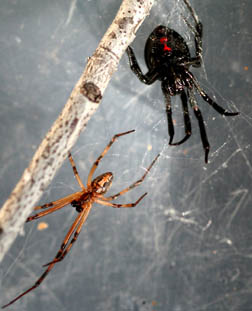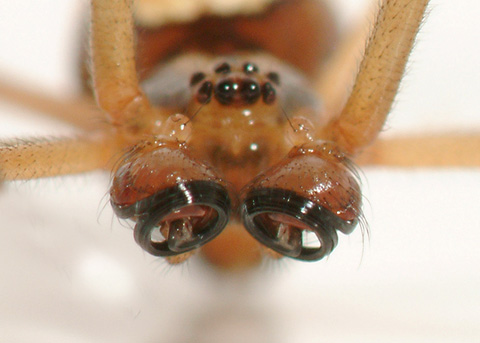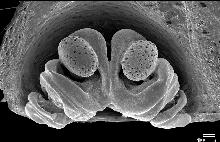Reproduction and Courtship
The L. hesperus has interesting courtship behavior especially given the difference in size of the male (smaller) and female (larger)!

Photo by Whitney Cranshaw
The males, once ready to mate, spin a web, deposit semen and
then takes in that semen into specialized structures on the ends
of their pedipalps called an embolus (Smithsonian
National Museum of Natural History 2012). Examples of pedipalps can be seen below.
![]() They then abandon
their own web in search of a female and do not hunt or consume food
until they find one. Once a female is found, the male tap on the
female's web in a sort of Morse code along with vibrating their
abdomen to get the female in the 'mood'. If that doesn't work, another strategy is for him to cut the
females web in order to diminish her routes of escape. He then
caressed her legs, then abdomen and when he feels safe, climbs on
top of her (Ross and Smith 1979).
They then abandon
their own web in search of a female and do not hunt or consume food
until they find one. Once a female is found, the male tap on the
female's web in a sort of Morse code along with vibrating their
abdomen to get the female in the 'mood'. If that doesn't work, another strategy is for him to cut the
females web in order to diminish her routes of escape. He then
caressed her legs, then abdomen and when he feels safe, climbs on
top of her (Ross and Smith 1979).

Photo found in Ross and Smith 1979
The male then inserts his sperm-charged pedipalps into her genital opening (epigynum, seen below). The majority of male L. hesperus lose either one or both of their emboli in the female's epigynum leaving the male impotent (Ross and Smith 1979). This is the point at which the male spider may or may not be eaten. In North America, only one of the three types of Latrodectus spiders has been witnessed eating their mate (L. mactens). This may be disappointing to some because their common name, Black Widows, is based on the myth that the species' females commonly eat their mates. This cannibalism would make sense, on an evolutionary standpoint, because after their first mating most males cannot impregnate a female again, they are evolutionarily useless and might as well be used as energy for the breeding female. Ah well, I guess even evolution doesn't always win.
After mating, the female black widow creates an egg sac, as seen below, that can contain somewhere between 100-500 eggs. The gestation time for L. hesperus is around 14 days (Animal Diversity Web 2001).
The spiderlings that hatch may or may not live to maturity depending upon whether their siblings become cannabilistic or not along with other common factors for survival (predation, nutrition, etc.) (Drees and Jackman 1999).
The spiderlings that survive mature at different rates depending on gender. Males mature the fastest at about 70 days whereas the females take about 90 days (Animal Diversity Web 2001).




